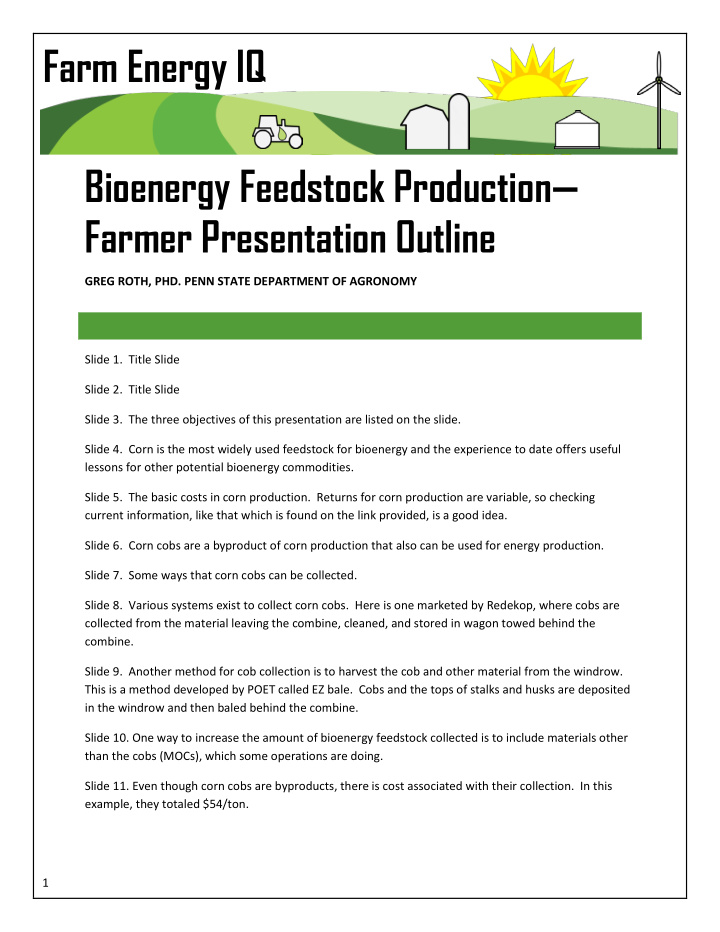



Farm Energy IQ Bioenergy Feedstock Production— Farmer Presentation Outline GREG ROTH, PHD. PENN STATE DEPARTMENT OF AGRONOMY Slide 1. Title Slide Slide 2. Title Slide Slide 3. The three objectives of this presentation are listed on the slide. Slide 4. Corn is the most widely used feedstock for bioenergy and the experience to date offers useful lessons for other potential bioenergy commodities. Slide 5. The basic costs in corn production. Returns for corn production are variable, so checking current information, like that which is found on the link provided, is a good idea. Slide 6. Corn cobs are a byproduct of corn production that also can be used for energy production. Slide 7. Some ways that corn cobs can be collected. Slide 8. Various systems exist to collect corn cobs. Here is one marketed by Redekop, where cobs are collected from the material leaving the combine, cleaned, and stored in wagon towed behind the combine. Slide 9. Another method for cob collection is to harvest the cob and other material from the windrow. This is a method developed by POET called EZ bale. Cobs and the tops of stalks and husks are deposited in the windrow and then baled behind the combine. Slide 10. One way to increase the amount of bioenergy feedstock collected is to include materials other than the cobs (MOCs), which some operations are doing. Slide 11. Even though corn cobs are byproducts, there is cost associated with their collection. In this example, they totaled $54/ton. 1
Slide 12. Alternative uses of cobs for mushroom compost, animal bedding or as a polishing compound can add value to the commodity when the market for cobs for energy is low. Another value added use is the potential impact on corn yields. Slide 13. Soybeans are often grown for protein meal, but the oil can also be extracted as a biodiesel feedstock. Note that the energy yield from biodiesel oil is lower than that for corn ethanol (31.5 million Btu), but soybeans have valuable rotation benefits in the cropping system. Slide 14. Basic production costs for soybeans. Slide 15. Canola, or rapeseed as it is called in many areas (including Europe), is another oilseed crop that is in the mustard family. It has higher oil content (38-40%) than soybeans (19-20%), and thus a higher oil yield/acre. Slide 16. An example of the production cost of canola. It is very similar to a small grain crop like wheat. Slide 17. This shows a canola field being combined. Unlike wheat, however, the straw has little value. It is not very absorbent and has many seeds. Slide 18. Canola can be pressed into a high protein meal and canola oil using an on-farm press like this one. Slide 19. Canola meal can be marketed as a quality protein supplement for many types of livestock. Finding small retail markets for canola meal can add to profitability. Slide 20. This spreadsheet, developed by the University of Vermont, helps producers estimate the potential profit associated with oilseed production and processing. Slide 21. Switchgrass is a widely adapted perennial grass that can be grown on marginal lands. This slide describes some of the energy potential, yield, and other attributes of switchgrass. Slide 22. Once established, switchgrass management is fairly simple, as described on this graph, with a single harvest in late winter or early spring. Slide 33. This slide describes the cost of the production in both the establishment year and after the crop has been established. This is from Penn State. Slide 24. Here is a summary of some of the key issues facing switchgrass development as a bioenergy feedstock. Slide 25. Miscanthus is a widely adapted warm season perennial grass, native to Eastern Asia, and now grown in Europe, and Southern, Eastern and Midwestern U.S. This shows a comparison of Miscanthus and switchgrass growing in Lancaster County, Pennsylvania. Slide 26. An example of management in the establishment year for Miscanthus. Slide 27. An example of management in the post establishment years for Miscanthus. Slide 28. Summary of costs in the initial year and years 4 through 15. 2
Slide 29. Some issues of Miscanthus biomass production, which includes the need for a buffer around the field to prevent spreading. Slide 30. Shrub willow is another biomass energy feedstock. This slide presents some production characteristics associated with shrub willow. Willows grow on good soils as well as on marginal soils, not droughty or excessively wet, and sloped less than 8% for harvesting. Slide 31. This describes shrub willow management over a 21-year span, with harvests occurring in years 5, 9, 13, 17, and 21. Slide 32. In this example, the annual income over 21 years was $36/acre. Slide 33. Some of the issues associated with shrub willow. Slide 34. Summary of the concepts discussed in this presentation. Slide 35. Further summary. Slide 36. Final summary. Slide 37: Questions. This project supported by the Northeast Sustainable Agriculture Research and Education (SARE) program. SARE is a program of the National Institute of Food and Agriculture, U.S. Department of Agriculture. Significant efforts have been made to ensure the accuracy of the material in this report, but errors do occasionally occur, and variations in system performance are to be expected from location to location and from year to year. Any mention of brand names or models in this report is intended to be of an educational nature only, and does not imply any endorsement for or against the product. The organizations participating in this project are committed to equal access to programs, facilities, admission and employment for all persons. 3
Recommend
More recommend